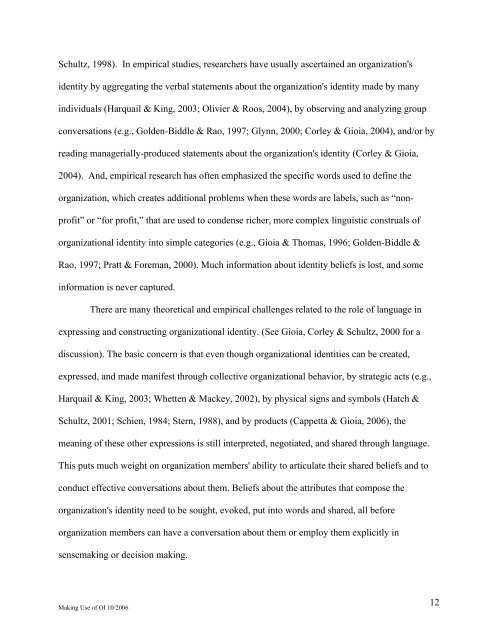Making Use of Organizational Identity - Authentic Organizations
Making Use of Organizational Identity - Authentic Organizations
Making Use of Organizational Identity - Authentic Organizations
Create successful ePaper yourself
Turn your PDF publications into a flip-book with our unique Google optimized e-Paper software.
Schultz, 1998). In empirical studies, researchers have usually ascertained an organization's<br />
identity by aggregating the verbal statements about the organization's identity made by many<br />
individuals (Harquail & King, 2003; Olivier & Roos, 2004), by observing and analyzing group<br />
conversations (e.g., Golden-Biddle & Rao, 1997; Glynn, 2000; Corley & Gioia, 2004), and/or by<br />
reading managerially-produced statements about the organization's identity (Corley & Gioia,<br />
2004). And, empirical research has <strong>of</strong>ten emphasized the specific words used to define the<br />
organization, which creates additional problems when these words are labels, such as “nonpr<strong>of</strong>it”<br />
or “for pr<strong>of</strong>it,” that are used to condense richer, more complex linguistic construals <strong>of</strong><br />
organizational identity into simple categories (e.g., Gioia & Thomas, 1996; Golden-Biddle &<br />
Rao, 1997; Pratt & Foreman, 2000). Much information about identity beliefs is lost, and some<br />
information is never captured.<br />
There are many theoretical and empirical challenges related to the role <strong>of</strong> language in<br />
expressing and constructing organizational identity. (See Gioia, Corley & Schultz, 2000 for a<br />
discussion). The basic concern is that even though organizational identities can be created,<br />
expressed, and made manifest through collective organizational behavior, by strategic acts (e.g.,<br />
Harquail & King, 2003; Whetten & Mackey, 2002), by physical signs and symbols (Hatch &<br />
Schultz, 2001; Schien, 1984; Stern, 1988), and by products (Cappetta & Gioia, 2006), the<br />
meaning <strong>of</strong> these other expressions is still interpreted, negotiated, and shared through language.<br />
This puts much weight on organization members' ability to articulate their shared beliefs and to<br />
conduct effective conversations about them. Beliefs about the attributes that compose the<br />
organization's identity need to be sought, evoked, put into words and shared, all before<br />
organization members can have a conversation about them or employ them explicitly in<br />
sensemaking or decision making.<br />
<strong>Making</strong> <strong>Use</strong> <strong>of</strong> OI 10/2006<br />
12


